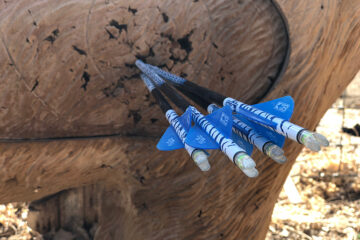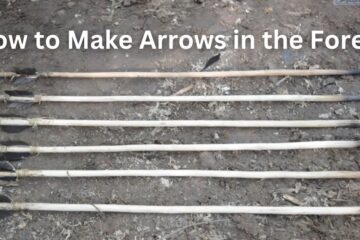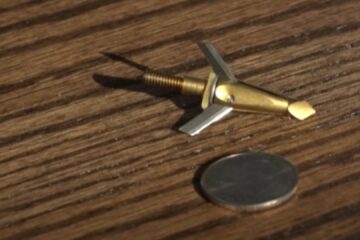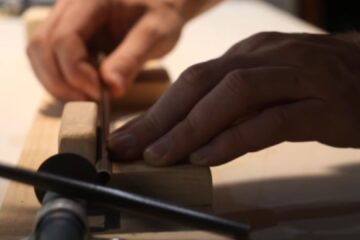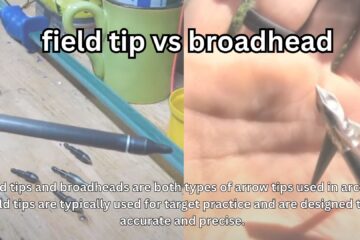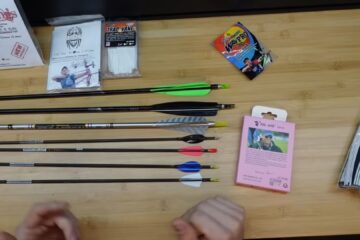A mechanical broadhead works by deploying its blades upon impact, causing maximum tissue damage and blood loss. Mechanical broadheads are an essential tool for hunters and archers, designed to increase the chances of a successful and ethical kill.
Unlike traditional fixed-blade broadheads, mechanical broadheads have blades that remain closed during flight, minimizing air friction and improving accuracy. Upon impact, the blades deploy, creating a larger cutting surface and increasing the wound channel. This results in enhanced tissue damage, causing rapid blood loss and ultimately ensuring a quicker and more humane kill.
The mechanical design allows for deeper penetration, making it an ideal choice for hunting larger game animals. However, it is important to note that mechanical broadheads require careful tuning to match the archer’s bow and arrow setup to ensure optimum performance.
How A Mechanical Broadhead Expands On Impact
A mechanical broadhead is designed to expand upon impact, maximizing its cutting diameter and potential damage to the target. This expansion is facilitated through several key factors, including the blades’ design and construction, the transfer of kinetic energy, and the use of a mechanical triggering mechanism. Understanding how these elements work together can provide valuable insights into the effectiveness and efficiency of a mechanical broadhead.
Blades’ design and construction
The design and construction of the blades play a crucial role in the expansion of a mechanical broadhead upon impact. The blades are typically housed within a compact casing, which helps maintain their integrity during flight and ensures proper alignment for optimal performance upon impact. The blades themselves are often made of high-quality stainless steel, chosen for its durability and sharpness. The blade edges are typically sharpened to a razor-like precision, enabling them to slice through the target with minimal resistance.
One common design feature of mechanical broadhead blades is their deployment mechanism. When the broadhead strikes the target, the force of impact triggers the blades to extend from their resting position, dramatically increasing the cutting diameter. This expansion can vary depending on the design, ranging from a few inches to more than double the width of the broadhead. The rapid expansion of the blades ensures a wider wound channel, increasing the likelihood of a clean and efficient kill.
Kinetic energy transfer
Kinetic energy transfer is another critical aspect that contributes to the expansion of a mechanical broadhead on impact. Kinetic energy is the energy of motion possessed by the arrow as it flies towards its target. When the broadhead strikes the target, this energy is transferred to the broadhead and the target itself. The high-speed transfer of kinetic energy causes the blades to deploy and expand, penetrating the target with substantial force.
The size and weight of the arrow, as well as the speed at which it is shot, all play a role in determining the amount of kinetic energy transferred to the broadhead on impact. A heavier arrow or a faster shot will impart more energy to the mechanical broadhead, resulting in faster and more significant expansion. This transfer of kinetic energy is crucial in ensuring an effective and lethal shot.
Mechanical triggering mechanism
The mechanical triggering mechanism in a mechanical broadhead ensures consistent and reliable expansion upon impact. This mechanism is often activated by the force of impact, causing the blades to deploy and expand. The design and functionality of the triggering mechanism may vary between different brands and models of mechanical broadheads.
One common type of triggering mechanism is the use of a spring or a piston system. When the broadhead contacts the target, the force exerted on the system compresses the spring or drives the piston forward, releasing the blades from their resting position. This mechanical triggering mechanism guarantees that the blades expand reliably and uniformly, increasing the effectiveness of the broadhead’s cutting diameter.
In summary, the expansion of a mechanical broadhead on impact is a result of its meticulously designed blades, the efficient transfer of kinetic energy, and the implementation of a mechanical triggering mechanism. These elements work together to maximize the cutting diameter and potential damage inflicted on the target, making mechanical broadheads a favored choice among bowhunters seeking reliable and lethal shots.
The Role Of Weight Distribution In Mechanical Broadheads
Weight distribution plays a crucial role in the performance of mechanical broadheads. The distribution of weight determines how the broadhead flies through the air, how it impacts the target, and ultimately affects the overall accuracy and effectiveness of the shot. In this article, we will delve into the significance of weight distribution in mechanical broadheads, focusing on the center of gravity, rear-deploying vs. front-deploying designs, and their effects on flight stability and accuracy.
Center of Gravity
The center of gravity is a key concept when it comes to weight distribution in mechanical broadheads. It refers to the point within the broadhead where all the individual components’ weight balances out. To achieve optimal flight performance, the center of gravity should be located as close to the leading edge of the broadhead as possible.
A well-balanced center of gravity ensures that the broadhead maintains stability during its trajectory, resulting in improved accuracy and penetration upon impact. If the center of gravity is too far forward, it can cause the broadhead to nosedive, leading to reduced accuracy and potentially poor target penetration. On the other hand, if the center of gravity is too far back, the broadhead may exhibit erratic flight behavior, making it difficult to achieve consistent shot placement.
Rear-deploying vs. Front-deploying Designs
Another factor that affects weight distribution in mechanical broadheads is the design type, specifically rear-deploying and front-deploying designs.
TABLE: Weight Distribution in Rear-deploying vs. Front-deploying Designs
| Design Type | Weight Distribution |
| Rear-deploying | The weight is concentrated towards the back of the broadhead |
| Front-deploying | The weight is distributed towards the front of the broadhead |
Rear-deploying designs typically have most of their weight concentrated towards the back of the broadhead, closer to the trailing edge. This weight distribution allows the broadhead to maintain stability and better flight control during the arrow’s trajectory. The rear-deploying design is known for its consistent flight and accuracy, making it a popular choice among bow hunters.
Front-deploying designs, on the other hand, have their weight distributed towards the front of the broadhead, near the leading edge. This weight distribution enhances the broadhead’s ability to open up upon impact, delivering maximum damage to the target. It is important to note that while front-deploying designs excel in terminal performance, they may be more prone to flight inconsistencies due to the forward weight bias.
Effects on Flight Stability and Accuracy
The weight distribution in mechanical broadheads significantly affects their flight stability and accuracy.
- A well-balanced weight distribution ensures a straighter flight path, reducing the chances of the broadhead deviating from its intended trajectory.
- Proper weight distribution minimizes the effects of wind resistance, allowing the broadhead to maintain a more stable flight even in windy conditions.
- With an optimized weight distribution, mechanical broadheads are more likely to hit the intended target with precision, resulting in higher accuracy and effective shot placement.
It is essential to understand the weight distribution of your chosen mechanical broadhead design and how it aligns with your shooting requirements. Each design may have its own pros and cons, and the choice ultimately depends on your personal preference, shooting style, and the type of game you pursue.
To sum it up, weight distribution plays a critical role in the performance of mechanical broadheads. The center of gravity, rear-deploying vs. front-deploying designs, and their effects on flight stability and accuracy should be carefully considered when selecting the most suitable broadhead for your hunting needs.
The Importance Of Blade Deployment Mechanisms
The Importance of Blade Deployment Mechanisms
When it comes to choosing a mechanical broadhead for your hunting adventures, understanding the intricacies of how it works is crucial. One key aspect to consider is the blade deployment mechanism. The effectiveness of a mechanical broadhead lies in its ability to deploy the blades reliably, quickly, and with precision. In this article, we will explore three essential types of blade deployment mechanisms: spring systems, O-ring technology, and mechanical locking mechanisms.
Spring systems
Spring systems play a vital role in the functioning of a mechanical broadhead. These systems rely on the stored energy in a compressed spring to launch the blades open upon impact with the target. As the arrow strikes, the spring releases its energy, causing the blades to deploy rapidly. The advantage of spring systems is their simplicity and reliability. They eliminate the need for any additional mechanisms, making them less prone to malfunctions or failures. Additionally, spring systems ensure that the blades open fully and lock in place, maximizing the broadhead’s cutting diameter and potential damage to the game.
O-ring technology
O-ring technology revolutionized blade deployment mechanisms in mechanical broadheads. These small rubber rings encircle the ferrule, keeping the blades in a closed position during flight. Upon impact, the force exerted on the O-rings causes them to break, allowing the blades to deploy. This innovative technology offers numerous benefits. Firstly, it ensures that the blades remain locked securely until the precise moment of impact, preventing premature deployment. Secondly, O-rings provide additional shock absorption, minimizing the risk of blade breakage upon striking hard bone or dense muscle. Lastly, this mechanism enhances the broadhead’s aerodynamic profile, promoting better accuracy and trajectory during flight.
Mechanical locking mechanisms
Mechanical locking mechanisms add an extra layer of security and reliability to the blade deployment process. These mechanisms typically employ a series of separate locking devices or levers that keep the blades in a closed position during flight. Upon impact, the kinetic energy triggers these locking mechanisms, allowing the blades to deploy. The advantage of mechanical locking mechanisms lies in their ability to hold the blades in place, even under high impact. This ensures that the blades remain intact and functional without any chance of accidental deployment. Additionally, the locking mechanisms often have built-in features that enable easy and safe blade retraction, making the broadhead reusable for multiple hunting trips.
In conclusion, understanding the significance of blade deployment mechanisms in mechanical broadheads is crucial for hunters seeking optimal performance and reliability. Spring systems, O-ring technology, and mechanical locking mechanisms each offer unique advantages, contributing to the overall effectiveness of the broadhead. By considering these factors, hunters can choose a mechanical broadhead that suits their specific needs, ensuring a successful and ethical hunting experience.
Penetrating Power And Wound Channels
When it comes to hunting with a bow and arrow, the effectiveness of your broadhead is crucial. A mechanical broadhead is a popular choice for hunters due to its ability to provide deep penetration and create devastating wound channels. In this section, we will explore how the blade angle and cutting diameter of a mechanical broadhead contribute to its penetrating power and the resulting effects on the prey.
Blade Angle and Cutting Diameter
The blade angle and cutting diameter of a mechanical broadhead play a significant role in determining its effectiveness. The blade angle refers to the slope of the blades in relation to the broadhead’s tip, while the cutting diameter is the width of the blades when fully deployed. These two factors work together to enhance the broadhead’s ability to penetrate the target and create a lethal wound channel.
A mechanical broadhead typically features blades that are angled forward, allowing them to act like miniature airplanes in flight. This aerodynamic design not only helps the broadhead fly accurately toward its target but also assists in providing deep penetration upon impact. The angled blades minimize friction and resistance, allowing the broadhead to slice through the air and reach a higher velocity. As a result, the broadhead can achieve greater kinetic energy upon impact, maximizing its penetrating power.
In addition to the blade angle, the cutting diameter of a mechanical broadhead also contributes to its effectiveness. With a larger cutting diameter, the broadhead can create a larger wound channel upon entry. This means that when the broadhead hits the target, it creates a substantial opening in the tissue, leading to increased blood loss and damage. The larger the wound channel, the more devastating the effects on the prey, increasing both the chances of a quick and ethical kill.
Devastating Wound Channels
The combination of the blade angle and cutting diameter of a mechanical broadhead results in the creation of devastating wound channels. As the broadhead makes contact with the prey, the angled blades cut through the tissue, expanding the wound channel. This expansion not only causes immediate damage but also hinders the prey’s ability to flee, as it may impede movement or affect vital organs.
A broader wound channel also translates to increased tissue damage and blood loss. The more significant the damage, the higher the chances of causing massive internal bleeding, which, in turn, increases the lethality of the shot. The broadhead’s ability to create a wound channel that disrupts vital organs and major blood vessels further ensures an ethical and swift kill, minimizing the suffering of the prey.
In conclusion, the penetrating power and wound-channels created by a mechanical broadhead depend on factors such as blade angle and cutting diameter. The angled blades and larger cutting diameter enhance the broadhead’s ability to penetrate deeply and create devastating wound channels. This, in turn, increases both the lethality of the shot and the chances of achieving a quick and humane kill. Therefore, hunters who opt for a mechanical broadhead can rely on its ability to deliver the necessary power and effectiveness when pursuing their target.
Factors Affecting Accuracy And Precision
When it comes to using mechanical broadheads, several factors can affect the accuracy and precision of your shot. Aligning and concentricity, wind resistance and arrow stabilization, and dual or single blade configurations play crucial roles in determining how well your broadhead performs. Understanding these factors can help you make better choices when it comes to equipment and improve your success rate in the field.
Alignment and Concentricity
One of the key factors affecting accuracy and precision when using a mechanical broadhead is the alignment and concentricity of the broadhead on the arrow shaft. Proper alignment ensures that the broadhead spins true and flies straight, minimizing any wobbling or deviation in flight.
Pro Tip: To achieve optimal alignment and concentricity, it is essential to carefully install the broadhead on the shaft, making sure that it sits squarely and is tightened securely. Pay attention to any potential inconsistencies in the arrow shaft, as these can also affect alignment.
Wind Resistance and Arrow Stabilization
Wind resistance can significantly impact the trajectory of your arrow and ultimately affect accuracy and precision. When shooting in windy conditions, it is crucial to choose a broadhead design that minimizes wind drag. Additionally, arrow stabilization plays a vital role in counteracting the effects of wind, ensuring a more accurate shot.
Pro Tip: Opt for mechanical broadheads that have sleek and streamlined designs, reducing wind resistance. Moreover, consider using arrow stabilizers or fletchings with high-profile vanes that can help stabilize the arrow in flight, improving accuracy even in challenging windy conditions.
Dual or Single Blade Configurations
The blade configuration of a mechanical broadhead can also impact its accuracy and precision upon impact. Both dual and single blade configurations have their advantages and considerations.
| Dual Blade Configuration | Single Blade Configuration |
| Offers increased cutting surface areaProvides faster and more effective blood lossRequires a larger entrance hole | Minimizes drag and wind resistancePenetrates deeper into targetsRequires a smaller entrance hole |
Pro Tip: Consider the type of game you are hunting and the specific requirements of your shot. For larger game, dual blade configurations may be more effective, while single blade configurations can offer superior penetration for smaller targets.
By understanding and considering these factors, you can make informed choices when selecting and using mechanical broadheads, significantly improving the accuracy and precision of your shots. Remember, proper alignment, minimizing wind resistance, and choosing the right blade configuration all contribute to successful and ethical hunting experiences.
Advantages And Limitations Of Mechanical Broadheads
When it comes to hunting with a bow and arrow, choosing the right broadhead can make all the difference in your success. Mechanical broadheads, also known as expandable broadheads, have gained popularity in recent years due to their unique design and functionality. In this article, we will explore the advantages and limitations of mechanical broadheads, including increased flight distance compared to fixed-blade broadheads, potential blade failure and mechanical malfunctions, and considerations for specific game hunting.
Increased flight distance compared to fixed-blade broadheads
One of the key advantages of mechanical broadheads is their increased flight distance compared to fixed-blade broadheads. The mechanical design allows the blades to remain streamlined during flight, minimizing drag and improving accuracy. The blades of a mechanical broadhead are usually concealed within the ferrule, which reduces the surface area exposed to the wind. This streamlined profile results in less wind resistance, allowing the arrow to travel longer distances with greater stability.
In addition to increased flight distance, mechanical broadheads also offer improved accuracy due to their high level of consistency. The blades are deployed upon impact, ensuring that each shot delivers consistent cutting diameter and penetration. This feature can be especially beneficial for long-range shots, where precision is crucial.
Potential blade failure and mechanical malfunctions
Despite their advantages, mechanical broadheads also have limitations that hunters should be aware of. One potential drawback is the risk of blade failure and mechanical malfunctions. Unlike fixed-blade broadheads, mechanical broadheads rely on the proper deployment and functioning of their internal mechanisms. If a blade fails to deploy, it can result in diminished cutting ability and reduced effectiveness. Additionally, the mechanical components of these broadheads are susceptible to wear, tear, and damage, which can hinder their performance.
It is important for hunters to carefully inspect their mechanical broadheads before each use and ensure that all components are in proper working condition. Regular maintenance, such as sharpening blades and lubricating mechanical parts, can help minimize the risk of malfunction. It is also crucial to choose high-quality mechanical broadheads from reputable manufacturers to reduce the likelihood of blade failure and mechanical malfunctions.
Considerations for specific game hunting
When it comes to specific game hunting, it is important to consider the limitations of mechanical broadheads and choose accordingly. While these broadheads are effective in many hunting scenarios, they may not be suitable for all game species. Some larger and tougher game animals, such as elk or grizzly bears, may require the added penetrating power of fixed-blade broadheads. Mechanical broadheads, with their expanding blades, may not provide the same level of penetration on heavily muscled or thick-skinned animals.
On the other hand, for smaller game species like whitetail deer or turkeys, the accuracy and increased flight distance offered by mechanical broadheads can be advantageous. These broadheads can deliver precise shots and make clean kills when used appropriately. However, it is essential to consider the specific characteristics of the game animal and select the broadhead that best suits the hunting situation.
In conclusion, mechanical broadheads offer several advantages, including increased flight distance and improved accuracy. However, hunters should also be aware of the potential for blade failure and mechanical malfunctions. When considering specific game hunting, it is important to choose a broadhead that aligns with the game species and their characteristics. By understanding the advantages and limitations of mechanical broadheads, hunters can make informed decisions and increase their chances of a successful hunt.
Selecting The Right Mechanical Broadhead For Your Needs
When it comes to bowhunting, choosing the right mechanical broadhead is crucial. There are several factors to consider, from determining the game type and intended distance to blade retention and replacement systems, as well as price, quality, and durability considerations. This guide will help you navigate through the important aspects of selecting the perfect mechanical broadhead for your specific needs.
Determining Game Type and Intended Distance
In order to select the right mechanical broadhead, it is essential to consider the type of game you will be hunting and the distance at which you expect to take your shot. Different broadheads are designed to be more effective on certain types of game, such as small game or large game. Additionally, the distance at which you are shooting plays a role in determining the appropriate mechanical broadhead to use. Some broadheads are designed to be more accurate and effective at longer distances.
Blade Retention and Replacement Systems
Blade retention and replacement systems are an important aspect to consider when selecting a mechanical broadhead. These systems ensure that the blades stay securely in place during flight and upon impact with the target. Look for broadheads that come with reliable retention mechanisms, such as O-rings or locking systems, to prevent premature blade deployment. Additionally, choose broadheads that offer a convenient blade replacement system, allowing you to easily replace the blades when necessary.
Price, Quality, and Durability Considerations
Price, quality, and durability are crucial factors to consider when selecting a mechanical broadhead. It’s important to find a balance between affordability and quality. Generally, higher-priced broadheads tend to offer better quality materials and construction, which can result in improved performance and durability. However, this doesn’t mean you have to break the bank to find a reliable mechanical broadhead. Look for reputable brands that offer a range of options to fit your budget and be sure to read product reviews to gauge their performance and durability.
Maintenance And Care For Mechanical Broadheads
As an avid bowhunter, it is essential to ensure that your mechanical broadheads are in top-notch condition for consistent accuracy and lethal performance. Proper maintenance and care not only extend the lifespan of your broadheads but also ensure their reliability when it matters most. In this section, we will discuss essential practices for maintaining and caring for your mechanical broadheads. From blade sharpening techniques to rust prevention and lubrication, as well as proper storage and handling recommendations, we have you covered.
Blade Sharpening Techniques
Keeping your mechanical broadhead blades sharp is crucial for achieving optimal penetration and a clean kill. Dull blades can lead to deflection or poor tissue cutting, potentially causing wounded animals. Here are a few blade sharpening techniques to keep your broadheads razor-sharp:
- Use a high-quality sharpening stone or diamond file to maintain a consistent angle while sharpening the blades. Aim for a 20 to 25-degree bevel for best results.
- Start with the backside (non-cutting edge) of the blade and work towards the cutting edge, maintaining a steady motion along the entire length of the blade. Repeat this process for each blade.
- Inspect the sharpness of the blades by carefully running your fingertip along the cutting edge. If it catches or feels rough, continue sharpening until smooth.
- After sharpening, remove any traces of metal debris or residue by wiping the blades with a clean cloth or using compressed air. Ensure they are completely dry before reassembling the broadhead.
Rust Prevention and Lubrication
Rust is the enemy of precision and can compromise the cutting efficiency of your mechanical broadheads. Regular rust prevention and lubrication routines are essential for preserving the integrity of your gear. Follow these steps to keep rust at bay:
- After every use, carefully inspect your broadheads for any signs of rust or corrosion. Even the smallest speck of rust can affect performance.
- If you notice any rust, use a fine-grit sandpaper or steel wool to remove it gently, being careful not to alter the shape of the blades.
- Apply a thin layer of rust-preventive oil or silicone-based lubricant to the blades and other metal components of the broadheads. This will create a protective barrier against moisture and oxidation.
- Store your broadheads in a dry environment, away from humidity and extreme temperature fluctuations. Consider using airtight containers or dedicated broadhead cases for added protection.
Proper Storage and Handling Recommendations
Properly storing and handling your mechanical broadheads is crucial to avoid accidental injuries and maintain their performance. Follow these recommendations for safe and efficient storage and handling:
- Always keep your broadheads out of reach of children and pets. Store them in a secure place, preferably in a locked cabinet or storage box.
- When removing or attaching broadheads from/to your arrows, exercise caution and use appropriate tools such as broadhead wrenches or pliers.
- Avoid storing broadheads with other metal objects that can cause damage or dull the blades.
- Inspect the mechanical mechanism of your broadheads before use and look for any signs of wear or malfunction. Replace any damaged or worn-out broadheads promptly.
Frequently Asked Questions For How Does A Mechanical Broadhead Work
How Does A Mechanical Broadhead Work?
A mechanical broadhead works by deploying its blades upon impact, expanding its cutting diameter for a larger wound channel. When shot, the kinetic energy opens the blades, creating devastating entry and exit wounds. The blades are designed to stay closed during flight for better accuracy and open upon hitting the target.
Are Mechanical Broadheads Better Than Fixed Blade Broadheads?
Mechanical broadheads offer several advantages over fixed blade broadheads. They typically fly more accurately due to their streamlined design, have larger cutting diameters, and cause deeper penetration. However, fixed blade broadheads are generally more durable and have better performance on bone.
How To Set Up A Mechanical Broadhead?
To properly set up a mechanical broadhead, ensure that the blades are sharp and undamaged. Adjust the blades and ensure proper alignment to avoid any interference with the arrow’s flight. Follow the manufacturer’s instructions for assembly and check the broadhead tightness.
Test the broadhead’s flight and make adjustments if necessary.
Conclusion
To sum it up, a mechanical broadhead operates by deploying blades upon impact, maximizing damage to the target. Its expanding design ensures better accuracy and deeper penetration, offering an advantage over fixed blade broadheads. By understanding how these broadheads work, archers can make informed choices for their hunting needs.
So, choose wisely and make the most of your hunting experience with a mechanical broadhead.


